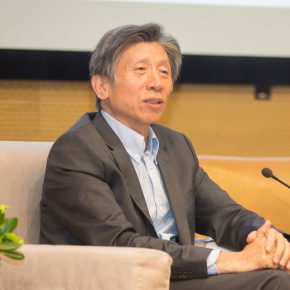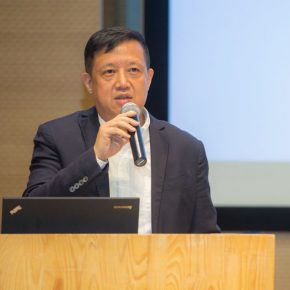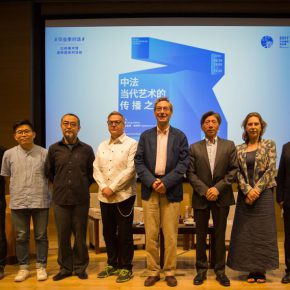
On May 24, 2017, a lecture for the graduation season entitled “Dimension of Communication on Sino-French Contemporary Art: Fan Di’an Dialogues with Alfred Pacquement, former Director of Musée national d’art moderne, Centre Pompidou” was held in the Auditorium of CAFA Art Museum. Invited guests, Fan Di’an, President of CAFA and Alfred Pacquement, former Director of Musée national d’art moderne, Centre Pompidou, France delivered speeches. Prof. Yu Ding, Dean of the Institute of Arts Administration and Education, CAFA served as the host.
At the start of the lecture, Prof. Yu Ding introduced the background of this dialogue: the graduation season of the year starts, this coincides with the holding of the Sino-French Cultural Spring of 2017, which holds a series of cultural and artistic activities. One of the major artistic activities is “Haute Tension, 8 lauréats du Prix Marcel Duchamp” that opened at the Red Brick Art Museum in Beijing on May 28. Alfred Pacquement is the curator of this exhibition.
President Fan Di’an addressed the opening ceremony and talked about the 20 years of friendship with Alfred Pacquement, as well as the course of ever-expanding and deepening cultural and artistic exchange between the two countries. Fan concluded that, “The relationship between China and France continues to involve in a shared vision on the aspects of politics, economy and trade, it is both a long standing and a constant innovation in cultural and artistic exchange. The Sino-French Cultural Year started planning at the beginning of this century, so that the people of China and France do not only deepen their understanding of each other’s artistic and cultural history, but also have deep mutual understanding on the levels of contemporary cultural development and contemporary art development”. Fan said that the exchange of cultural and artistic activities between China and France made CAFA become a beneficiary, and made CAFA establish a close relationship with many organizations of culture & art, and academic institutions in France, from the perspective of CAFA. “Sino-French Cultural Spring” series of projects which is held every spring and also offers colorful activities in performing arts, visual arts and even literature. These items have promoted the cultural exchange between the two countriesand deepening of the academic links.
Speaking of the theme of this lecture “Dimension of Communication”, Fan said that: “Communication” has an impact on the artistic creation and production which has become a feature for the times of information and image, so that, the function, value and meaning of “communication” has become worthy of study, what is the dimension of communication? What carrier or media is used to create the effectiveness and function of communication? Fan proposed that: “We are now in a world of communication. This happens in every corner of the world and can be shared by people at the same time. It also makes me think of another problem, namely what kind of interactive space does the current audience need? What system is used to approach art and enter an art space an audience?”
Alfred Pacquement first praised Fan who played a role in promoting people’s understanding of contemporary art and the propagation of contemporary art in China and foreign countries. On the other hand, he said that, Musée national d’art moderne, Centre Pompidou was different from other art museums, because “it is officially open to the current modern art”. Subsequently, Pacquement systematically introduced the establishment, history and selection system of the “Prix Marcel Duchamp”. He said that three winners of the “Prix Marcel Duchamp” will arrive in China and holding a discussion at the Red Brick Art Museum at 14:00 on Sunday.
Then Prof. Yu Ding asked questions and hoped the two speakers would talk about “Dimension of communication and the meaning of contemporary art” from different perspectives. Fan first delivered a speech and proposed that French cultural policies or cultural mechanisms were similar to those of China, for example, the government dominated the resources in public cultural services and had a considerable investment. In terms of communication, it contained the factor of “shared” when the word “communication” first appeared, who will share the “sharing”? Is the sharing for a group of people or the public sharing? In this current self-media age, what is the relationship between communication and media?
Pacquement said that, on the issue of communication, people should first consider how to classify information. “In the current field of contemporary art, there are some organizations that can carry out the classification of relevant information, for example, our current art academies, museums, art centers, etc.” For the role of “media” in artistic communication, Pacquement explained that, “Media” was the extreme role of the art market, although he did not oppose people who worked for the art market, he did not hope the market was the only decisive force for determining an artist that was worth enjoying. Finally, he concluded that: “The media-like operation is fine from the perspective of principle, as long as it is not the only way for the artist. But I still want to emphasize that public institutions should maintain their own direction, and I also hope to convey an important message to people, because some students from the academies believe that people can quickly gain their own reputation through the operation of the art system, which is not a solo road. Sometimes the pursuit of art takes a long time, walking along a long road, and I believe that people who ultimately succeed after hard work will certainly have more achievements than people who are famous within the media and business operation.
At the end of the lecture, Fan and Alfred Pacquement both exchanged views with the guests who were present, and answered the questions put forward by the students, and sent their good wishes to the students who were about to graduate.
Text by Liu Yunxuan, Edited by Lin Jiabin, translated by Chen Peihua and edited by Sue/CAFA ART INFO
Photo by Hu Sichen/CAFA ART INFO




































